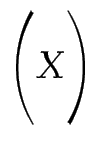9.4.9 Delimiters
Placing brackets around a tall object in maths mode, such as fractions, does not look right if you use normal sized brackets. For example:
results in:

\left<delimiter>
and
\right<delimiter>
Rewriting the above example:
produces:

Note that you must always have matching \left and
\right commands, although the delimiters used may be
different. If you want
one of the delimiters to be invisible, use a
. (full stop) as the delimiter. Available
delimiters are shown in
Table 9.13. (Note for a vertical bar
delimiter it's best to use amsmath's \lvert command instead of
| and \lVert instead of \|.) Sometimes using \left and
\right doesn't produce the optimal sized delimiters. In which
case you can use additional commands provided by the amsmath
package shown in Table 9.14.
| ( |
|
) |
|
[ |
|
] |
|
| \{ |
|
\} |
|
\lvert† |
|
\rvert† |
|
\lVert† |
|
\rVert† |
|
\langle |
|
\rangle |
|
\lfloor |
|
\rfloor |
|
\lceil |
|
\rceil |
|
\uparrow |
|
\downarrow |
|
\Uparrow |
|
\Downarrow |
|
\updownarrow |
|
\Updownarrow |
|
/ |
|
\backslash |
|
| Definitions | Example | |||||
| Default Size | $( X )$ |
|||||
\bigl<delim> |
\bigr<delim> |
$\bigl( X \bigr)$ |
|
|||
\Bigl<delim> |
\Bigr<delim> |
$\Bigl( X \Bigr)$ |
|
|||
\biggl<delim> |
\biggr<delim> |
$\bigl( X \biggr)$ |
|
|||
\Biggl<delim> |
\Biggr<delim> |
$\Biggl( X \Biggr)$ |

|
|||
Example (Vertical Bar Delimiters):

Example (Delimiter with Subscript):
Delimiters can take limits:

Example (Mismatch):
The left and right delimiters don't have to match:

Example (An invisible delimiter):
Every \right must have a matching \left (and vice versa), so
use a . (full stop) for an invisible
delimiter.

We have now covered enough to reproduce the equation shown in §1. Introduction:
\newcommand*{\pderiv}[2]{\frac{\partial #1}{\partial #2}}
\newcommand*{\e}{\mathrm{e}}
\[
\pderiv{^2\mathcal{L}}{{z_i^\rho}^2} =
-
\pderiv{\rho_i}{z_i^\rho}
\left(
\pderiv{v_i}{\rho_i} \frac{\e^{v_i}}{1-\e^{v_i}}
+ v_i
\frac{\e^{v_i}\pderiv{v_i}{\rho_i}(1-\e^{v_i})
+
\e^{2v_i}\pderiv{v_i}{\rho_i}}{(1-\e^{v_i})^2}
\right)
\]

Note:
The above code looks a bit complicated, and there are so many braces that it can be easy to lose track, so here are some ways of making it a little easier to type:
- Whenever you start a new environment type in the
\beginand\endbits first, and then insert whatever goes inside the environment. This ensures that you always have a matching\beginand\end. The same goes for \[ and \]. - Whenever you type any braces, always type the opening and closing braces first, and then insert whatever goes in between. This will ensure that your braces always match up.
So keeping these notes in mind, let's try typing in the code in a methodical manner:
- Start and end the displayed maths mode:
- We now need a partial derivative.
(The command
\pderivis defined as described earlier. Make sure you remember to define it, preferably in the preamble.) - Let's do the first argument. This partial derivative is
actually a double derivative, which means we need a squared bit on
the top along with a calligraphic L:
- The second argument is the
 squared bit. This is a
nested superscript
squared bit. This is a
nested superscript
{z_i^\rho}^2: - We can do the next partial derivative in the same way. This
one is slightly easier to do:
- Delimiters also need to occur in pairs, like curly braces and
\beginand\end, so let's do them next: - Now we need to do the bits inside the brackets. First of all
we have yet another partial derivative:
\[\pderiv{^2 \mathcal{L}}{{z_i^\rho}^2} =-\pderiv{\rho_i}{z_i^\rho}
\left(
\pderiv{v_i}{\rho_i}
\right)\] - Now we have a fraction following the partial derivative from
the previous step.
(Make sure you use braces for the exponential bit:
\e^{v_i}( ) is not the same as
) is not the same as \e^v_i( ). The
command
). The
command \eis defined as described earlier. Make sure you define it, preferably in the preamble.)\[\pderiv{^2 \mathcal{L}}{{z_i^\rho}^2} =-\pderiv{\rho_i}{z_i^\rho}
\left(
\pderiv{v_i}{\rho_i}\frac{\e^{v_i}}{1-\e^{v_i}}
\right)\] - This is followed by
 times another fraction:
times another fraction:
\[\pderiv{^2 \mathcal{L}}{{z_i^\rho}^2} =-\pderiv{\rho_i}{z_i^\rho}
\left(
\pderiv{v_i}{\rho_i}\frac{\e^{v_i}}{1-\e^{v_i}}
+ v_i\frac{}{}
\right)
\] - The bottom part of the
fraction (the denominator) is easier than the top, so let's do that first:
\[
\pderiv{^2\mathcal{L}}{{z_i^\rho}^2} =
-\pderiv{\rho_i}{z_i^\rho}
\left(
\pderiv{v_i}{\rho_i}\frac{\e^{v_i}}{1-\e^{v_i}}
+ v_i\frac{}{(1-\e^{v_i})^2}
\right)
\] - Now for the top part of the fraction (the numerator).
To refresh your memory, it should look like:

That's a bit complicated, so let's break it down:- The first term is:
- The next term is another partial derivative:
- Then we have:
- Next we have to add on:
- And finally we have:
So the numerator is:
\e^{v_i}\pderiv{v_i}{\rho_i}(1-\e^{v_i}) + \e^{2v_i}\pderiv{v_i}{\rho_i}Inserting this into our code:
- The first term is:
This book is also available as A4 PDF or 12.8cm x 9.6cm PDF or paperback (ISBN 978-1-909440-00-5).
